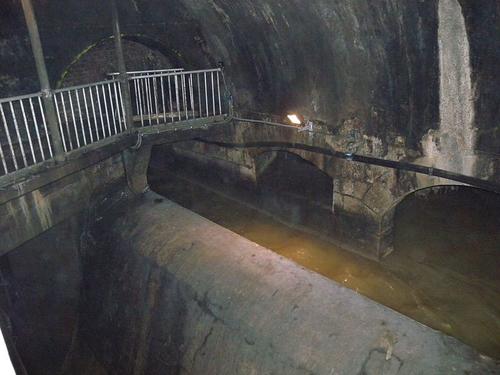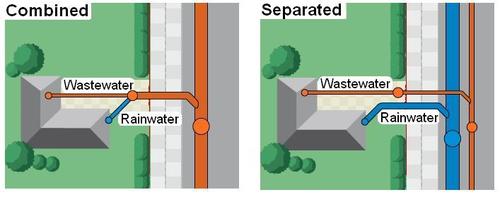Sewerage systems
A sewerage or sewer system collects wastewater. Sanitary sewers were designed and built to carry wastewater from domestic, industrial and commercial sources. (EPA 2004) Gravity is used to convey the wastewater wherever possible. Thus, it is not surprising that natural stormwater drainage is usually used. The principle of using gravity as the driving force for conveying wastewater in a sewerage system should be applied wherever possible, because this will minimize the cost of pumping. Sewerage systems can be mainly classified into combined sewerage and separate sewerage. Combined sewerage carries both stormwater and wastewater, while separate sewerage carries stormwater or wastewater separately. Recent trends have been for the development of separate sewerage systems. The main reason for this is that stormwater is generally less polluted than wastewater, and that treatment of combined wastewater and stormwater is difficult during heavy rainfalls, resulting in untreated overflows. In practice, there is usually ingress of stormwater into wastewater sewerage pipes, because of unsealed pipe joints, and unintentional or illegal connections of rainwater run-off. Conversely, there may be unintentional or illegal wastewater connections to stormwater sewerage. (UNEP 2000)
The graphic on the right illustrates the difference between a combined and a separated sewerage system and the table at the bottom shows the advantages and disadvantages of these two systems. Further types of sewer systems can be found at the end of this page.
In many developing countries, more than 70% of industrial wastes are dumped untreated into waters where they pollute the usable water supply. (WWAP 2009) In many countries, the responsibility for industrial wastewater treatment falls back on ordinary taxpayers. In the absence of a user pays system for pollution control, large volumes of contaminated industrial wastewater end up in municipal sewage treatment plants, which are expensive to construct, operate and maintain. The Netherlands introduced a series of incentives to polluters to reduce pollution at source, rather than opting for the more expensive end-of-pipe solution of public sewage treatment. This approach has been cost-effective in reaching water quality targets. (Corcoran et al. 2010) The treatment of industrial wastewaters before discharge to the sewer is also extremely important in preventing pollutants from entering the wastewater and stormwater systems. (UNEP 2000)
| Combined Sewers | Separated Sewers |
| Advantages | |
| Stormwater and wastewater can be managed at the same time | Stormwater and wastewater can be managed separately |
| Convenience (minimal intervention by users) | Convenience (minimal intervention by users) |
| Lower water demand | Limited or no risk of sewage overflow |
| Moderate operation and maintenance costs | Moderate operation costs |
| No problems related to discharging industrial wastewater | |
| Surface run-off and rainwater can be reused (e.g. for landscaping or agriculture) | |
| Disadvantages | |
| Need a reliable supply of piped water | Needs a reliable supply of piped water |
| High capital costs | High capital costs, more expensive than combined sewer system |
| Difficult to construct in high-density areas | Difficult to construct in high-density areas |
| Requires skilled engineers and operators | Requires skilled engineers and operators |
| Adequate treatment and/or disposal required | Adequate treatment and/or disposal required |
| Problems associated with blockages and breakdown of pumping equipment | Problems associated with blockages and breakdown of pumping equipment |
| Recycling of nutrients and energy becomes difficult | Need for pumping on flat ground |
| Risk of sewage overflow | Difficult and costly to maintain |
(adopted from Seyoum 2013)



